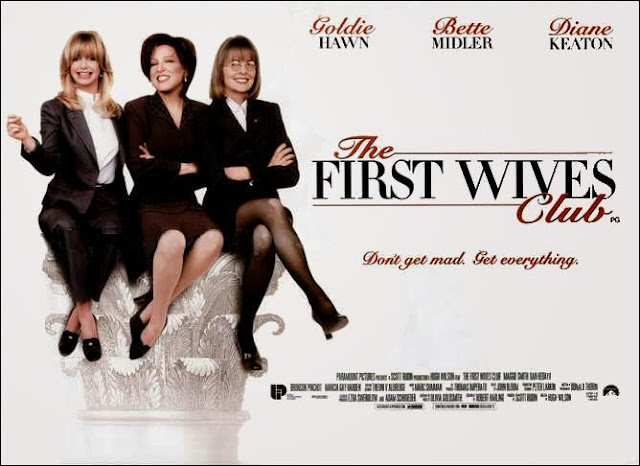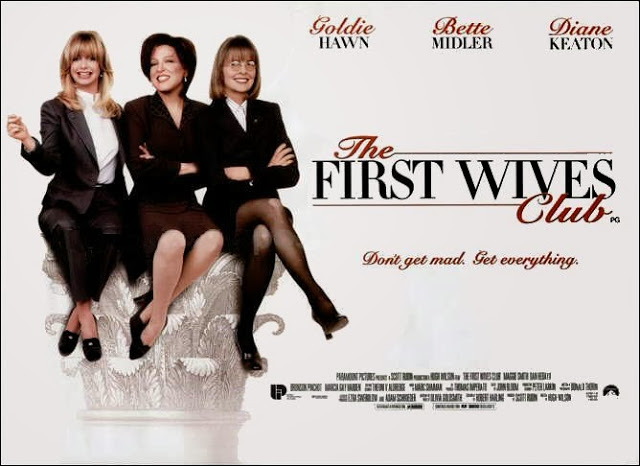 |
| Film poster for The First Wives Club |
The First Wives Club is the story of four women who became friends with each other when they were in college. After graduation, the friends ended up drifting apart. This is a situation that happens to a lot of women. Life gets in the way.
People get married, have children, and (hopefully) find “real jobs.” It becomes increasingly difficult to find the time (or the energy) to socialize with friends who are no longer a part of our day-to-day lives. When you are in your 20s, you truly believe that you will be best friends forever. You intend to stay connected. Years later, you wonder whatever happened to those friends (whom you haven’t heard from in years).
In the movie, three of the friends reunite after learning that the fourth friend, Cynthia Swann Griffin (played by Stockard Channing) died by suicide after her husband divorced her. The surviving friends are now in their mid-forties. Each one is either divorced or is going through the process of divorce.
The movie does a good job of picking up on some of the thoughts that women who are 40 or over struggle with. Elise Elliot (played by Goldie Hawn) is overly concerned about aging. There is a scene where she begs her plastic surgeon to make her lips fuller (again). He resists, reminding her of all the plastic surgery she has already undergone and pointing out that she is beautiful.
 |
| Elise looking for wrinkles at the plastic surgeon’s office |
She is a more extreme example of what many women (who are not actresses) feel when their hair starts turning gray and they begin to get “crow’s feet.” The fear is that these very natural parts of aging mean that the woman is no longer desirable, or sexy, or beautiful. There are women who are absolutely terrified of “getting old” because they worry that no one will want them.
Unfortunately, this fear is not an unfounded one. Elise’s husband, Bill Atchison (played by Victor Garber) is divorcing her and has started dating a woman who is much younger than than Elise. Tension builds when Elise is asked to play the role of “the mother” in a script where Bill’s new lover will play the lead role of the daughter.
A similar thing happened to Brenda Cushman (played by Bette Midler). She got married to Morton “Morty” Cushman when they were young, ran the cash register in his electronics stores, and had a son with him. Now, Brenda is 45 and Morty has left her and gotten into a serious relationship with Shelly Stewart (played by Sarah Jessica Parker). Brenda and Morty’s fifteen-year-old son has trouble coping with this situation.
Brenda laments to her friends that everything with she and Morty was just fine. Then, on their 20th wedding anniversary, Morty began having what Brenda calls a mid-life crisis. In short, he decides that she isn’t fun anymore and is holding him back. He replaces her with a thinner, younger, blond woman who is about half her age.
 |
| “Who’s supposed to wear that? Some anorexic teenager?” |
Annie Paradis (played by Diane Keaton) has a slightly different story. She isn’t actually divorced yet. She and her husband Aaron Paradis (played by Stephen Collins) are separated. They had been going to couple’s therapy but now are each seeing a therapist individually. Annie truly believes that they are in the process of working things out and getting back together.
Her daughter, Chris Paradis (played by Jennifer Dundas) describes her mother as a “doormat.” Chris is a college student and old enough to see that her father isn’t treating her mother very well. She is frustrated that her mom allows it. Unlike Brenda’s son, Chris doesn’t want her parents to get back together.
There is a scene where Annie is going on (what she believes) is a date with Aaron. She is convinced that he is going to tell her that he wants to get back together. Instead, after they have become intimate in his hotel room, he announces that he wants a divorce. This completely destroys Annie.
She is a woman who, like many women, has issues with self-esteem. After a lifetime of suppressing her anger, and striving to always be “nice,” Annie finally lets out her feelings in a loud, sobbing, messy way. At the same time, the phrase she uses most often during this catharsis is “I’m sorry.”
 |
| Annie screaming “I’m sorry!!!” |
Later, the women start to want more than revenge. They decide to turn their efforts toward helping other divorced women. Again, this requires their ex-husbands, whom they have now managed to blackmail, to spend more money. To me, this part of the plot felt a bit forced and strange. The change from “let’s get ’em” to “let’s open a charity” was rather abrupt.
The First Wives Club was released in 1996, a time when almost no one carried a cell phone. As such, the majority of phone calls that take place in the movie are done on land-line phones with clunky receivers. There is a scene where Brenda goes out to dinner by herself. She doesn’t spend the meal fiddling with her cell phone – and neither do any of the other people in the restaurant. Times have changed since the late 1990’s (and realizing this makes me feel “old”).

1 thought on “Older Women Week: ‘The First Wives Club’: "Don’t Get Mad. Get Everything."”
Comments are closed.